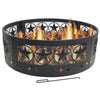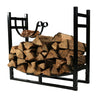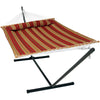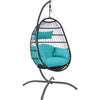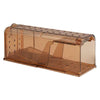It's the perfect night for a fire.
The wind is still, the night is young, and your friends and family are ready for a relaxing evening by the fire. Now all that’s left is to gather up some firewood.
The only problem, however, is choosing the right type of firewood to get the best burn.
But how will you decide which firewood is the best for burning?
The last thing you need is firewood that gets smoky or refuses to stay lit. We’ve all been around those types of fires…they can be quite the let-down.
That’s exactly why we’ve created this guide on the best firewood to burn for your fireplace, wood stove, or backyard fire pit.
We’re here to help you extinguish your worries with all you need to know about picking the best firewood to burn for your next fire, whether it’s for a bonfire, indoor fireplace, or wood-burning stove.
Before we delve into wood types, we must first be familiar with what makes wood burnable.

What Makes Wood Burnable?
Wood is wood right? Wrong! There are in fact several factors that determine how firewood burns.
In general, a harder denser wood will burn longer. This is why the five species of wood on our list are all hardwoods. Softer wood won’t burn as long, but it catches fire easier and makes for great kindling.
In order for firewood to burn best, however, the wood has to first be properly seasoned.
Seasoning
No, seasoning doesn’t involve delicately sprinkling exotic spices onto raw lumber.
Seasoning simply refers to the drying process for wood to burn the most effectively.
When the logs are split and stacked right away, it allows the moisture to escape faster. Keeping the wood elevated off the ground on a log rack will also help the wood properly dry.
To learn more on how to season firewood, make sure to check out our article on the best tips to season firewood quickly.

The moisture content of firewood can be classified into these two categories:
Heat output
Now that the firewood is fully seasoned, it can provide the most warmth when it’s ready to burn.
British Thermal Units, or BTUs, are the required amount to heat one pound of water by 1-degree Fahrenheit.
When it comes to firewood, the higher BTU value, the more heat the firewood produces. The BTU rating of wood is higher when the wood is well-seasoned and also depends on the species of wood.
Now that we understand what BTU values mean, we can compare five of the best firewood types for your next fire. First, let’s look at oak wood.

The 5 Best Types of Firewood to Burn
Oak
Because oak is so abundant in North America, it makes for a viable firewood option that’s relatively easy to find.
It produces about 24 million BTUs per cord and burns quite clean when dry. Oak is a very dense hardwood, which allows it to burn longer. While readily available and effective, oak takes one to two years to fully season.
Hickory
Hickory is one of the hottest burning firewood's around. At a whopping average of 28.5 million BTUs per cord, hickory is sure to provide plenty of warmth for the largest of gatherings.
Since hickory is a very dense wood, it takes at least a year to properly season but burns very clean and smells quite pleasant. This added aroma will certainly make those backyard cookouts very enjoyable!
Apple
Just like hickory, apple wood is another fantastic smelling wood when burned and is often used to smoke meats. (How about them apples?) This clean-burning wood burns quite hot at around 26.6 million BTUs per cord.
In order to be properly seasoned, apple wood requires one year minimum to dry.

Birch
Another fantastic option for your next campfire is birch.
While this firewood produces less BTUs than oak at around 20 million BTUs per cord, this wood only needs 9-12 months to properly season.
As a sweet bonus, the bark on birch wood can be peeled right off of the rest of the wood. The papery bark can be used as kindling to start your fire.

White Ash
Last but not least, ash wood is a fantastic choice across the board.
At around 23.6 million BTUs per cord, it burns at a value in the same league as oak wood. On average it only requires about six months to fully season and produces a clean burn with no smoke.
Types of Wood to Avoid Burning In Your Fireplace
Soft Woods
While soft woods are a viable option for backyard fires, it is not recommended for indoor fireplaces or wood stoves.
Soft woods burn extremely fast and create a lot of smoke, which can cause rapid build-up of soot in your chimney.
To find out if the wood you are using is soft, check out this top softest woods article by the wood database
Driftwood
Another type of wood that should be avoided is driftwood.
Driftwood contain chlorine, which creates substances that are known to cause cancer when burned in a fire.
"Poison" Woods
Any type of wood that contains the word "poison" should not be used in your fireplace.
Even materials like poison ivy should never be used in a fire because they can release substances into the smoke that can be life-threatening.
Mexican Elder
This specific type of wood comes from a fast-growing tree normally found in southern states and should not be used in your fireplace.
Breathing in the smoke of this wood is extremely dangerous and can lead to cyanide poisoning.
Old Wood
Any rotten or old wood should never be burned or even brought in the house.
Old wood won't produce nearly as much heat as seasoned wood and there is a good chance the rotten wood is infested with insects, bugs, and termites that you don't want infesting your home.
Get That Fire Started Today!
Well, there it is! Five fantastic types of wood that’ll keep you and your peers warm during your next fire.
Ultimately choosing wood that’s very dense and is seasoned properly will make preparation much easier so you can enjoy the warmth faster.
For all your firepit needs, be sure to check out our vast selection of fire pits and log racks.





